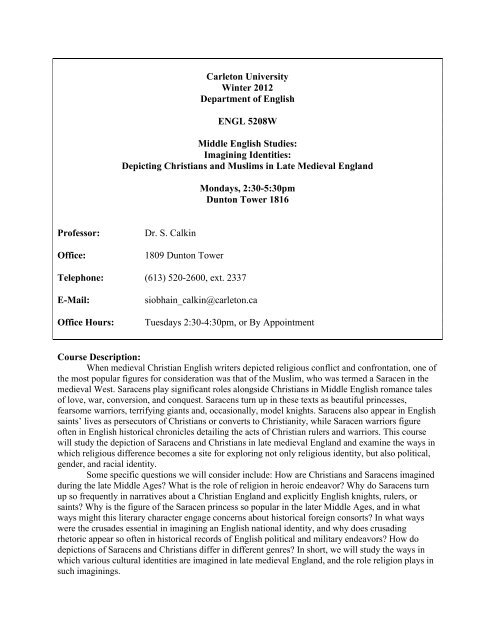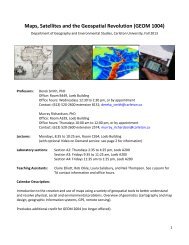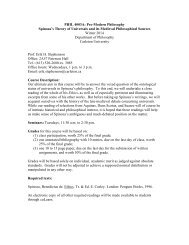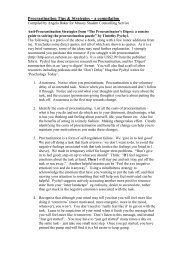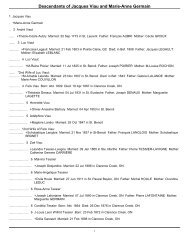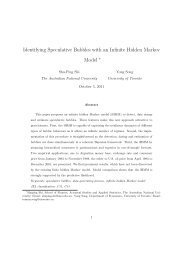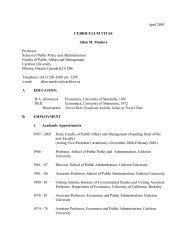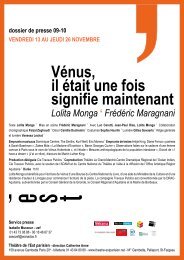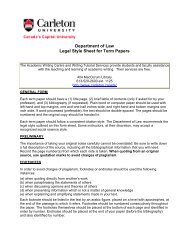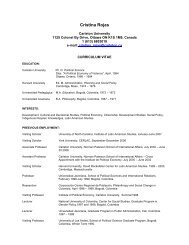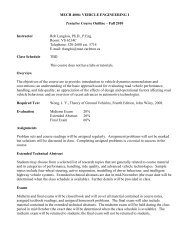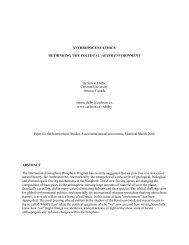Depicting Christians and Muslims in Late Medieval England
Depicting Christians and Muslims in Late Medieval England
Depicting Christians and Muslims in Late Medieval England
You also want an ePaper? Increase the reach of your titles
YUMPU automatically turns print PDFs into web optimized ePapers that Google loves.
Carleton UniversityW<strong>in</strong>ter 2012Department of EnglishENGL 5208WMiddle English Studies:Imag<strong>in</strong><strong>in</strong>g Identities:<strong>Depict<strong>in</strong>g</strong> <strong>Christians</strong> <strong>and</strong> <strong>Muslims</strong> <strong>in</strong> <strong>Late</strong> <strong>Medieval</strong> Engl<strong>and</strong>Mondays, 2:30-5:30pmDunton Tower 1816Professor:Office:Dr. S. Calk<strong>in</strong>1809 Dunton TowerTelephone: (613) 520-2600, ext. 2337E-Mail:Office Hours:siobha<strong>in</strong>_calk<strong>in</strong>@carleton.caTuesdays 2:30-4:30pm, or By Appo<strong>in</strong>tmentCourse Description:When medieval Christian English writers depicted religious conflict <strong>and</strong> confrontation, one ofthe most popular figures for consideration was that of the Muslim, who was termed a Saracen <strong>in</strong> themedieval West. Saracens play significant roles alongside <strong>Christians</strong> <strong>in</strong> Middle English romance talesof love, war, conversion, <strong>and</strong> conquest. Saracens turn up <strong>in</strong> these texts as beautiful pr<strong>in</strong>cesses,fearsome warriors, terrify<strong>in</strong>g giants <strong>and</strong>, occasionally, model knights. Saracens also appear <strong>in</strong> Englishsa<strong>in</strong>ts’ lives as persecutors of <strong>Christians</strong> or converts to Christianity, while Saracen warriors figureoften <strong>in</strong> English historical chronicles detail<strong>in</strong>g the acts of Christian rulers <strong>and</strong> warriors. This coursewill study the depiction of Saracens <strong>and</strong> <strong>Christians</strong> <strong>in</strong> late medieval Engl<strong>and</strong> <strong>and</strong> exam<strong>in</strong>e the ways <strong>in</strong>which religious difference becomes a site for explor<strong>in</strong>g not only religious identity, but also political,gender, <strong>and</strong> racial identity.Some specific questions we will consider <strong>in</strong>clude: How are <strong>Christians</strong> <strong>and</strong> Saracens imag<strong>in</strong>eddur<strong>in</strong>g the late Middle Ages? What is the role of religion <strong>in</strong> heroic endeavor? Why do Saracens turnup so frequently <strong>in</strong> narratives about a Christian Engl<strong>and</strong> <strong>and</strong> explicitly English knights, rulers, orsa<strong>in</strong>ts? Why is the figure of the Saracen pr<strong>in</strong>cess so popular <strong>in</strong> the later Middle Ages, <strong>and</strong> <strong>in</strong> whatways might this literary character engage concerns about historical foreign consorts? In what wayswere the crusades essential <strong>in</strong> imag<strong>in</strong><strong>in</strong>g an English national identity, <strong>and</strong> why does crusad<strong>in</strong>grhetoric appear so often <strong>in</strong> historical records of English political <strong>and</strong> military endeavors? How dodepictions of Saracens <strong>and</strong> <strong>Christians</strong> differ <strong>in</strong> different genres? In short, we will study the ways <strong>in</strong>which various cultural identities are imag<strong>in</strong>ed <strong>in</strong> late medieval Engl<strong>and</strong>, <strong>and</strong> the role religion plays <strong>in</strong>such imag<strong>in</strong><strong>in</strong>gs.
Course Objectives:Students <strong>in</strong> this course will:Read a variety of texts <strong>and</strong> genres from medieval Engl<strong>and</strong> (romances, sa<strong>in</strong>ts’ lives, chronicleexcerpts, drama)Read a range of secondary scholarship on the texts studiedDevelop an appreciation <strong>and</strong> underst<strong>and</strong><strong>in</strong>g of the Middle English language as well as afacility with read<strong>in</strong>g <strong>and</strong> quot<strong>in</strong>g itExplore some of the ways <strong>in</strong> which medieval English texts engage questions of religion, race,gender, violence, history, otherness, <strong>and</strong> community formationDevelop a historical <strong>and</strong> historicized underst<strong>and</strong><strong>in</strong>g of the depictions of <strong>Christians</strong> <strong>and</strong><strong>Muslims</strong> <strong>in</strong> late medieval Engl<strong>and</strong> <strong>and</strong> some of the ends to which these representations wereputBecome familiar with current critical discussions about medieval western depictions ofreligious alterityFamiliarize themselves with the characteristics of texts produced <strong>in</strong> a manuscript culture, <strong>and</strong>with the different ways <strong>in</strong> which such texts are presented todayRequired Texts:The French text, the Song of Rol<strong>and</strong>, will be read <strong>in</strong> modern English translation, as will theLat<strong>in</strong> <strong>and</strong> Arabic chronicles of the Third Crusade. All other texts will be read <strong>in</strong> MiddleEnglish. Assistance with read<strong>in</strong>g Middle English will be provided as needed. Song of Rol<strong>and</strong>, trans. Glyn Burgess (London: Pengu<strong>in</strong>, 1990)Three Middle English Charlemagne Romances, ed. Alan Lupack (Kalamazoo: WesternMichigan University <strong>Medieval</strong> Institute Publications, 1990) TEAMS Series Middle English Legends of Women Sa<strong>in</strong>ts, ed. Sherry L. Reames (Kalamazoo: WesternMichigan University <strong>Medieval</strong> Institute Publications, 2003) TEAMS SeriesFour Romances of Engl<strong>and</strong>, ed. Ronald B. Herzman, Graham Drake, <strong>and</strong> Eve Salisbury(Kalamazoo: Western Michigan University <strong>Medieval</strong> Institute Publications, 1999)TEAMS SeriesK<strong>in</strong>g Arthur's Death, ed. Larry Benson (Kalamazoo: Western Michigan University<strong>Medieval</strong> Institute Publications, 1994) TEAMS Series2
* Books will be available at Haven Books, 43 Seneca Street (Seneca at Sunnyside)Telephone: 613-730-9888E-mail: <strong>in</strong>fo@havenbooks.caWeb: www.havenbooks.ca/carletonsite/carletonhome-e.phpPlease Note: There are also a number of supplementary read<strong>in</strong>gs on reserve at the library for thiscourse. See the Course Calendar for titles.Evaluation (see Course Calendar for due dates):Manuscript Assignment 10%An assignment to transcribe <strong>and</strong> edit 10-15 l<strong>in</strong>es of Middle English poetry from a manuscriptreproduction. You will be expected to provide the edited l<strong>in</strong>es, a description of the h<strong>and</strong>, <strong>and</strong>a brief rationale for your edition. Instruction <strong>in</strong> the tasks <strong>and</strong> assistance with them will beprovided.Short Article Summary 5%A brief (one-page s<strong>in</strong>gle-spaced maximum) written summary of one scholarly article listed asa Supplementary Read<strong>in</strong>g for this course. The summary should be posted on WebCT 24 hoursbefore the class date under which the read<strong>in</strong>g is listed so that everyone may read thesummary <strong>and</strong> our discussion may be enriched by your work.Sem<strong>in</strong>ar Presentation 35%A 60-m<strong>in</strong>ute sem<strong>in</strong>ar presentation on issues related to the text(s) assigned for the day of yourpresentation. You should present <strong>in</strong>formation for 30 of those m<strong>in</strong>utes <strong>and</strong> lead classdiscussion for the other 30 m<strong>in</strong>utes. Secondary research is required, as are a one-pageoutl<strong>in</strong>e of the presentation <strong>and</strong> a list of the sources used.Term Paper15-20 page paper 40%MLA or Chicago Style is required.Attendance <strong>and</strong> Participation 10%See distributed list of expectationsPlagiarism:The University Senate def<strong>in</strong>es plagiarism as present<strong>in</strong>g, whether <strong>in</strong>tentionally or not,the ideas, expression of ideas, or the work of others as one’s own.This can <strong>in</strong>clude: reproduc<strong>in</strong>g or paraphras<strong>in</strong>g portions of someone else’s published or unpublishedmaterial, regardless of the source, <strong>and</strong> present<strong>in</strong>g these as one’s own withoutproper citation or reference to the orig<strong>in</strong>al source3
submitt<strong>in</strong>g a take-home exam<strong>in</strong>ation, essay, laboratory report or other assignmentwritten, <strong>in</strong> whole or <strong>in</strong> part, by someone elseus<strong>in</strong>g ideas, quotations, or paraphrased material, concepts or ideas withoutappropriate acknowledgement <strong>in</strong> an essay or assignmentfail<strong>in</strong>g to acknowledge sources through the use of proper citations when us<strong>in</strong>ganother’s works, <strong>and</strong>/or fail<strong>in</strong>g to use quotation marksh<strong>and</strong><strong>in</strong>g <strong>in</strong> substantially the same piece of work for academic credit more thanonce without prior written permission of the course <strong>in</strong>structor <strong>in</strong> which thesubmission occursPlagiarism is a form of <strong>in</strong>tellectual theft, <strong>and</strong> constitutes an Instructional Offence at Carleton. Seethe statement on Instructional Offences.Please Note: St<strong>and</strong><strong>in</strong>g <strong>in</strong> a course is determ<strong>in</strong>ed by the course <strong>in</strong>structor subject to the approvalof the Faculty Dean. This means that grades submitted by the <strong>in</strong>structor may be subject torevision. No grades are f<strong>in</strong>al until they have been approved by the Dean.Please Note as well: If one of your assignments is lost, misplaced, or not received by the<strong>in</strong>structor, you are responsible for hav<strong>in</strong>g a backup copy that can be submitted immediately uponrequest.Requests for Academic Accommodations:You may need special arrangements to meet your academic obligations dur<strong>in</strong>g the term becauseof disability, pregnancy or religious obligations. Please review the course outl<strong>in</strong>e promptly <strong>and</strong>write to me with any requests for academic accommodation dur<strong>in</strong>g the first two weeks of class, oras soon as possible after the need for accommodation is known to exist.Students with disabilities requir<strong>in</strong>g academic accommodations <strong>in</strong> this course must register withthe Paul Menton Centre for Students with Disabilities (PMC) for a formal evaluation ofdisability-related needs. Documented disabilities could <strong>in</strong>clude but are not limited tomobility/physical impairments, specific Learn<strong>in</strong>g Disabilities (LD), psychiatric/psychologicaldisabilities, sensory disabilities, Attention Deficit Hyperactivity Disorder (ADHD), <strong>and</strong> chronicmedical conditions. Registered PMC students are required to contact the PMC, 613-520-6608,every term to ensure that your Instructor receives your Letter of Accommodation, no later thantwo weeks before the first assignment is due or the first <strong>in</strong>-class test/midterm requir<strong>in</strong>gaccommodations. If you only require accommodations for your formally scheduled exam(s),please submit your request for accommodations to PMC by the last official day to withdraw fromclasses <strong>in</strong> each term.You can visit the Equity Services website to view the policies <strong>and</strong> to obta<strong>in</strong> more detailed<strong>in</strong>formation on academic accommodation at http://carleton.ca/equity/accommodation.4
Calendar of Classes <strong>and</strong> Read<strong>in</strong>gs:Class meets <strong>in</strong> Room 1816 of Dunton Tower. Read<strong>in</strong>gs are to be completed for class bythe date under which they are listed. Please note that I reserve the right to adjust this syllabus tomeet the needs of the class; however, major changes will be announced <strong>in</strong> advance.Please Note: (R) means On Reserve at the LibraryM. Jan. 9 Introduction to CourseHistorical contexts, key terms, <strong>and</strong> issuesM. Jan. 16 Song of Rol<strong>and</strong>Sharon K<strong>in</strong>oshita, “’Pagans are wrong <strong>and</strong> <strong>Christians</strong> are right’: From parias tocrusade <strong>in</strong> the Chanson de Rol<strong>and</strong>,” Chapter 1 of <strong>Medieval</strong> Boundaries:Reth<strong>in</strong>k<strong>in</strong>g Difference <strong>in</strong> Old French Literature (Philadelphia, 2006) (R)Supplementary Read<strong>in</strong>gs:Peter Haidu, The Subject of Violence: The Song of Rol<strong>and</strong> <strong>and</strong> the Birth of theState (Bloom<strong>in</strong>gton, 1993) Introduction, Chapter 2, Chapter 3, orChapter 9 (R)M. Jan. 23 Sultan of Babylon (<strong>in</strong> Three Middle English Charlemagne Romances)Carole Hillenbr<strong>and</strong>, “How the <strong>Muslims</strong> Saw the Franks: Ethnic <strong>and</strong> ReligiousStereotypes,” Chapter 5 of The Crusades: Islamic Perspectives (NewYork, 2000)(R)Supplementary Read<strong>in</strong>gs:*Michael Camille, “Idols of the Saracens,” pp. 129-64 <strong>in</strong> The Gothic Idol:Ideology <strong>and</strong> Image-Mak<strong>in</strong>g <strong>in</strong> <strong>Medieval</strong> Art (Cambridge, 1989) (R)*Jeffrey Jerome Cohen, “On Saracen Enjoyment: Some Fantasies of Race <strong>in</strong><strong>Late</strong> <strong>Medieval</strong> France <strong>and</strong> Engl<strong>and</strong>,” Journal of <strong>Medieval</strong> <strong>and</strong>Early Modern Studies 31.1 (2001): 113-46 (R)*Sarah Lambert, “Hero<strong>in</strong>es <strong>and</strong> Saracens,” <strong>Medieval</strong> World 1 (1991): 3-9(From Professor)Marianne Ailes <strong>and</strong> Phillipa Hardman, “How English are the EnglishCharlemagne Romances?” <strong>in</strong> Boundaries <strong>in</strong> <strong>Medieval</strong> Romance, ed.Cartlidge (Cambridge, 2008), pp. 43-56 (From Professor)Robert Warm, “Identity, Narrative <strong>and</strong> Participation: def<strong>in</strong><strong>in</strong>g a context for theMiddle English Charlemagne Romances,” <strong>in</strong> Tradition <strong>and</strong>Transformation <strong>in</strong> <strong>Medieval</strong> Romance, ed. Field (Cambridge, 1999), pp.87-100 (R)5
M. Jan. 30 St Margaret of Antioch—versions <strong>in</strong> Middle English Legends of Women Sa<strong>in</strong>ts (111-168)St Kather<strong>in</strong>e of Alex<strong>and</strong>ria––versions <strong>in</strong> Middle English Legends of Women Sa<strong>in</strong>ts (169-221)Supplementary Read<strong>in</strong>gs:*Sarah Salih, “Introduction: Sa<strong>in</strong>ts, Cults <strong>and</strong> Lives <strong>in</strong> <strong>Late</strong> <strong>Medieval</strong>Engl<strong>and</strong>,” <strong>in</strong> A Companion to Middle English Hagiography, ed. Salih(Cambridge, 2006), pp. 1-24 (R)*Claire M. Waters, “Power <strong>and</strong> Authority,” <strong>in</strong> Companion to Middle EnglishHagiography, pp. 70-86 (R)*Karen W<strong>in</strong>stead, any chapter from Virg<strong>in</strong> Martyrs: Legends of Sa<strong>in</strong>thood <strong>in</strong><strong>Late</strong> <strong>Medieval</strong> Engl<strong>and</strong> (Ithaca, 1997) (R)Kather<strong>in</strong>e Lewis, “’Lete Me Suffre’: Read<strong>in</strong>g the Torture of St Margaret ofAntioch <strong>in</strong> <strong>Late</strong> <strong>Medieval</strong> Engl<strong>and</strong>,” <strong>in</strong> <strong>Medieval</strong> Women: Texts <strong>and</strong>Contexts <strong>in</strong> <strong>Late</strong> <strong>Medieval</strong> Brita<strong>in</strong>: Essays for Felicity Riddy, ed. Wogan-Browne, Voaden, Diamond, Hutchison, Meale, <strong>and</strong> Johnson (Turnhout,2000), pp. 69-82 (R)Kather<strong>in</strong>e Lewis, any chapter from The Cult of St Kather<strong>in</strong>e of Alex<strong>and</strong>ria <strong>in</strong><strong>Late</strong> <strong>Medieval</strong> Engl<strong>and</strong> (Woodbridge, 2000)(R)Siobha<strong>in</strong> Bly Calk<strong>in</strong>, “Saracens <strong>and</strong> English Christian Identity <strong>in</strong> SeyntKater<strong>in</strong>e <strong>and</strong> Seynt Mergrete,” <strong>in</strong> Saracens <strong>and</strong> the Mak<strong>in</strong>g of EnglishIdentity (New York, 2005) (R)M. Feb. 6 Excerpts from: Lives of St. Thomas Becket <strong>and</strong> his parents (available from profor onl<strong>in</strong>e through WebCT l<strong>in</strong>k to:www.archive.org/details/earlysouthengli00librgoog, Book pp. 106-25,157-77; e-book pp. beg<strong>in</strong> 162)Excerpts from Digby MS Play of Mary Magdalen (read enough to get sense ofsa<strong>in</strong>t’s life, then focus on episodes <strong>in</strong>volv<strong>in</strong>g the K<strong>in</strong>g of Marsyle afterMary’s repentance/conversion; available on-l<strong>in</strong>e by WebCT l<strong>in</strong>k to:www.umm.ma<strong>in</strong>e.edu/faculty/necastro/drama/magdalene.txt)Supplementary Read<strong>in</strong>gs:*Beth Crachiolo, “See<strong>in</strong>g the Gender<strong>in</strong>g of Violence: Female <strong>and</strong> MaleMartyrs <strong>in</strong> the South English Legendary,” <strong>in</strong> A Great Effusion ofBlood? Interpret<strong>in</strong>g <strong>Medieval</strong> Violence, ed. Meyerson, Tiery <strong>and</strong> Falk(Toronto, 2004), pp. 147-63 (R)Dawn Marie Hayes, “Body as Champion of Church Authority <strong>and</strong> SacredPlace: The Murder of Thomas Becket,” <strong>in</strong> A Great Effusion of Blood?,pp. 190-215 (R)*Suzanne Conkl<strong>in</strong> Akbari, Idols <strong>in</strong> the East: European Representations of6
Islam <strong>and</strong> the Orient, 1100-1450 (Ithaca, 2009), Chapter 5 “EmptyIdols <strong>and</strong> a False Prophet,” pp. 200-47 (From Professor)M. Feb. 13 Due Date: Edit<strong>in</strong>g AssignmentF<strong>in</strong>ish Becket <strong>and</strong> Digby Mary Magdalen if necessaryRichard Coer de Lyon (available as PDF on l<strong>in</strong>e at WebCT l<strong>in</strong>k towww.archive.org/details/dermittelenglisc00brun), l<strong>in</strong>es 1-3758Supplementary Read<strong>in</strong>gs:*Gerald<strong>in</strong>e Heng, Empire of Magic: <strong>Medieval</strong> Romance <strong>and</strong> the Politics ofCultural Fantasy (New York, 2003), pp. 17-46 <strong>and</strong> Chapter 2 (“TheRomance of Engl<strong>and</strong>: Richard Coer de Lyon <strong>and</strong> the Politics of Race,Religion, Sexuality, <strong>and</strong> Nation”) (R)Nicola F. McDonald, “Eat<strong>in</strong>g People <strong>and</strong> the Alimentary Logic of RichardCoeur de Lion,” <strong>in</strong> Pulp Fictions of <strong>Medieval</strong> Engl<strong>and</strong>: Essays <strong>in</strong>Popular Romance, ed. McDonald (Manchester, 2004), pp. 124-50 (R)Alan Ambrisco, “Cannibalism <strong>and</strong> Cultural Encounters <strong>in</strong> Richard Coeur deLion,” Journal of <strong>Medieval</strong> <strong>and</strong> Early Modern Studies 29.3 (1999):499-528 (R)M. Feb. 20 NO CLASS––READING WEEKM. Feb. 27 F<strong>in</strong>ish Richard Coer de Lyon, l<strong>in</strong>es 3758-7212Supplementary Read<strong>in</strong>gs:John F<strong>in</strong>layson, “Richard Coer de Lyon romance, history or someth<strong>in</strong>g <strong>in</strong>between?” Studies <strong>in</strong> Philology 87.2 (1990): 156-80 (R)Lesley A. Coote, “Laugh<strong>in</strong>g at Monsters <strong>in</strong> Richard Coeur de Lyon,” <strong>in</strong> GrantRisee? The <strong>Medieval</strong> Comic Presence: Essays <strong>in</strong> memory of Brian J.Levy, ed. Tudor <strong>and</strong> H<strong>in</strong>dley (Turnhout, 2006), pp. 193-211 (R)M. Mar. 5 The Chronicle of the Third Crusade: The It<strong>in</strong>erarium Peregr<strong>in</strong>orum et GestaRegis Ricardi, trans. Nicholson (Aldershot, 1997) (R)––pp. 23-35, 38-9, 142-6, 201-8, 213, 220-31, 251-61, 269-81, 294-5,297, 300-2, 339-43, 347-86Bahā’ al-Dīn Ibn Shaddād, The Rare <strong>and</strong> Excellent History of Salad<strong>in</strong>, trans.Richards (Aldershot, 2002) (R)––pp. 28-29, 35-38, 72-78, 101-6, 146-8, 150-1, 155-65, 172-8,185-6, 192-6, 217-33, 2367
Supplementary Read<strong>in</strong>gs:Carole Hillenbr<strong>and</strong>, The Crusades: Islamic Perspectives, Chapters 4 or 6 (R)M. Mar. 12 K<strong>in</strong>g of Tars (Electronic R)Chaucer’s Man of Law’s Tale (<strong>in</strong> whatever edition you have)Supplementary Read<strong>in</strong>gs:Jane Gilbert, “Putt<strong>in</strong>g the Pulp <strong>in</strong>to Fiction: The Lump-Child <strong>and</strong> its Parents <strong>in</strong>The K<strong>in</strong>g of Tars,” <strong>in</strong> Pulp Fictions of <strong>Medieval</strong> Engl<strong>and</strong>, pp. 102-23 (R)Lisa Lampert, “Race, Periodicity, <strong>and</strong> the neo-Middle Ages,” ModernLanguage Quarterly 65.3 (2004): 391-421 (R)Siobha<strong>in</strong> Bly Calk<strong>in</strong>, “Monstrous Interm<strong>in</strong>gl<strong>in</strong>g <strong>and</strong> Miraculous Conversion:Negotiat<strong>in</strong>g Cultural Borders <strong>in</strong> The K<strong>in</strong>g of Tars,” <strong>in</strong> Saracens <strong>and</strong> theMak<strong>in</strong>g of English Identity (R)Gerald<strong>in</strong>e Heng, “Beauty <strong>and</strong> the East,” <strong>in</strong> Empire of Magic (R)*Kathryn L. Lynch, “Storytell<strong>in</strong>g, Exchange <strong>and</strong> Constancy: East <strong>and</strong> West <strong>in</strong>Chaucer’s Man of Law’s Tale,” Chaucer Review 33 (1999): 409-22 (R)*Kathy Lavezzo, “Beyond Rome: Mapp<strong>in</strong>g Gender <strong>and</strong> Justice <strong>in</strong> The Man ofLaw’s Tale,” Studies <strong>in</strong> the Age of Chaucer 24 (2001): 149-80 (R)Carolyn D<strong>in</strong>shaw, “Pale Faces: Race, Religion <strong>and</strong> Affect <strong>in</strong> Chaucer’s Texts<strong>and</strong> Their Readers,” Studies <strong>in</strong> the Age of Chaucer 24 (2001): 19-41. (R)Susan Schibanoff, “Worlds Apart: Orientalism, Antifem<strong>in</strong>ism <strong>and</strong> Heresy <strong>in</strong>Chaucer’s Man of Law’s Tale,” Exemplaria 8 (1996): 59-96 (R)M. Mar. 19 F<strong>in</strong>ish Man of Law’s Tale (if necessary)Bevis of Hampton (<strong>in</strong> Four Romances of Engl<strong>and</strong>)Supplementary Read<strong>in</strong>gs:*Sir Bevis of Hampton <strong>in</strong> Literary Tradition, ed. Fellows <strong>and</strong> Djordjevic(Cambridge, 2008), any of Chapters 7-11 (R)M. Mar. 26 NO CLASS––PROF AT CONFERENCEDue Date: Paper Proposal Posted to WebCT for commentsM. Apr. 2 F<strong>in</strong>ish Bevis of Hampton (if necessary)Alliterative Morte Arthure (<strong>in</strong> K<strong>in</strong>g Arthur’s Death)8
Supplementary Read<strong>in</strong>gs:*Christ<strong>in</strong>e Chism, “K<strong>in</strong>g Takes Knight,” <strong>in</strong> Alliterative Revivals (Philadelphia,2002) (R)Mary Hamel, “The ‘Christen<strong>in</strong>g’ of Sir Priamus <strong>in</strong> the Alliterative MorteArthure” Viator 13 (1982): 295-307 (R)Gerald<strong>in</strong>e Heng, “Warr<strong>in</strong>g Aga<strong>in</strong>st Modernity” <strong>in</strong> Empire of Magic ((R)Arlyn Diamond, “Heroic Subjects: Women <strong>and</strong> the Alliterative MorteArthure,” <strong>in</strong> <strong>Medieval</strong> Women: Texts <strong>and</strong> Contexts, pp. 293-308 (R)Mutually agreed date/time:F<strong>in</strong>ish Alliterative Morte Arthure if necessaryClos<strong>in</strong>g Discussion? <strong>Medieval</strong> Potluck?T. Apr. 10 NO CLASSDue Date: Term Paper9


